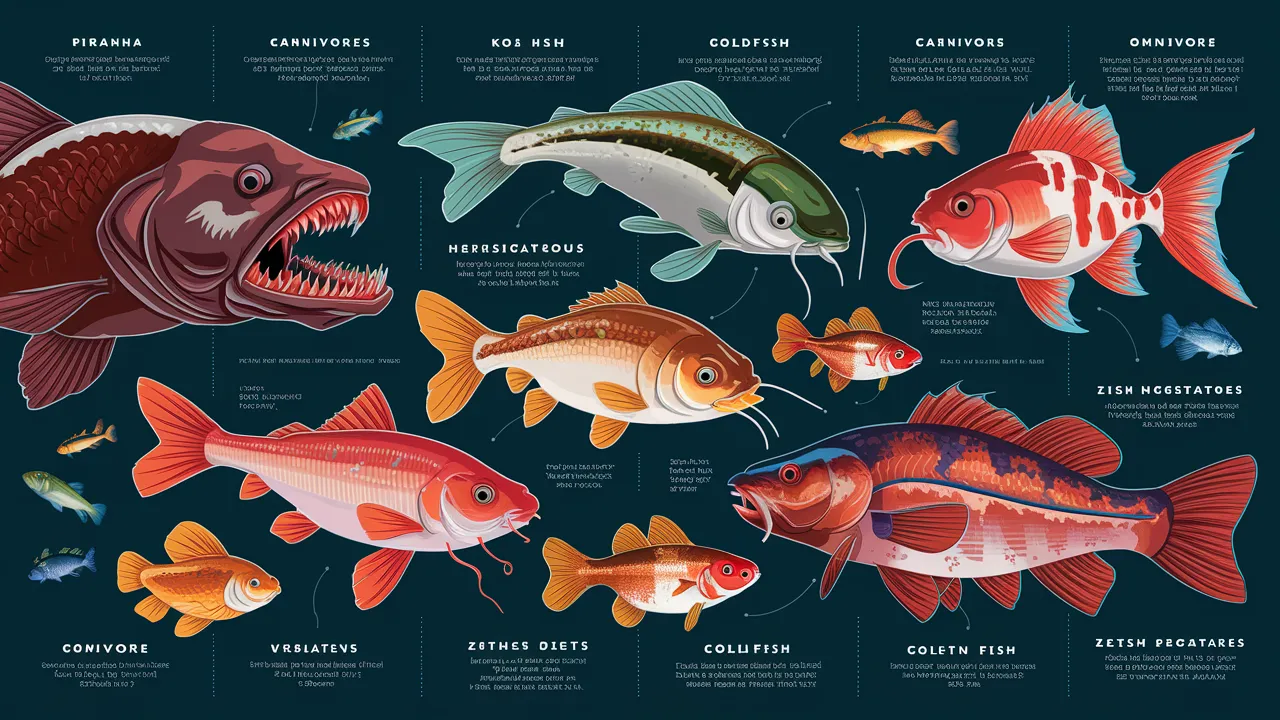Fish are one of the most diverse groups of animals on the planet, with thousands of species inhabiting various aquatic environments. One of the most common questions asked by aquarium enthusiasts and nature lovers alike is: Are fish omnivores? Koi Fish Information will explore the dietary classifications of fish, including omnivores, carnivores, and herbivores, and provide insights into the feeding habits of various fish species.
Understanding Fish Diets

Types of Fish Diets
Fish can be broadly categorized into three dietary groups:
- Carnivores: Fish that primarily eat other animals, including smaller fish, crustaceans, and invertebrates.
- Herbivores: Fish that primarily consume plant matter, including algae, seaweed, and other aquatic vegetation.
- Omnivores: Fish that eat both plant and animal matter, making them versatile feeders.
Are Fish Omnivores?
To answer the question, are fish omnivores?, we need to consider the diversity of fish species. Many fish exhibit omnivorous feeding habits, consuming a mix of plant and animal matter. However, not all fish are omnivores, as some species are strictly carnivorous or herbivorous.
Characteristics of Omnivorous Fish
Omnivorous fish possess specific adaptations that allow them to thrive on a varied diet. Here are some key characteristics:
Digestive Adaptations
Omnivorous fish generally have a more complex digestive system compared to strict carnivores or herbivores. They possess enzymes that can break down both plant materials and animal proteins, enabling them to extract nutrients from a diverse range of food sources.
Feeding Behaviors
Omnivorous fish often display varied feeding behaviors, including:
- Foraging: Searching for food on the substrate or in the water column.
- Grazing: Feeding on algae and plant matter.
- Hunting: Actively pursuing smaller fish or invertebrates.
Versatile Diet
Omnivorous fish can adapt their diet based on food availability in their environment. This flexibility allows them to thrive in various habitats, from freshwater rivers to marine ecosystems.
Examples of Omnivorous Fish
Here are some well-known examples of omnivorous fish:
Goldfish
Goldfish are a popular aquarium species that exhibit omnivorous feeding habits. They consume a diet that includes flakes, pellets, vegetables, and even small insects. Their ability to eat a variety of foods makes them a favorite among aquarium enthusiasts.
Betta Fish
Betta fish are known for their vibrant colors and aggressive behavior. They are primarily carnivorous but also eat plant matter, making them omnivorous. Bettas thrive on a diet of high-quality pellets, freeze-dried foods, and occasional vegetables.
Guppies
Guppies are small, colorful fish that are also omnivores. They feed on algae, plant matter, and small organisms such as daphnia and brine shrimp. Their versatility in diet allows them to thrive in various freshwater environments.
Tetras
Tetras, such as neon tetras and ember tetras, are small schooling fish that exhibit omnivorous habits. They consume a diet that includes flakes, micro-pellets, and small live foods, along with algae.
Are Fish Carnivores?
While many fish are omnivores, others are strictly carnivorous. Carnivorous fish primarily consume other fish, invertebrates, and meat-based foods. Here are some examples:
Piranhas
Piranhas are notorious carnivorous fish known for their sharp teeth and strong jaws. They primarily feed on smaller fish and aquatic animals, making them apex predators in their habitats.
Catfish
Certain species of catfish are carnivorous, preying on smaller fish, insects, and invertebrates. Their barbels help them sense food in murky waters, allowing them to hunt effectively.
Barracudas
Barracudas are aggressive carnivores that hunt smaller fish. They are fast swimmers with sharp teeth, making them formidable predators in the ocean.
Is a Fish an Omnivore?
The term “fish” encompasses a diverse range of species, each with unique dietary habits. Thus, the answer to “is a fish an omnivore?” can vary:
- Yes, many fish are omnivores: Species such as goldfish, guppies, and tetras thrive on a mixed diet of plant and animal matter.
- No, some fish are strictly carnivores or herbivores: For example, piranhas are strict carnivores, while certain species of parrotfish primarily consume algae.
Understanding Herbivorous Fish
To complete the dietary overview, it’s important to mention herbivorous fish. These fish primarily feed on plant matter, including algae, seaweed, and aquatic plants. Here are some examples:
Surgeonfish
Surgeonfish, such as the popular blue tang, are primarily herbivorous. They graze on algae growing on rocks and coral, playing a crucial role in maintaining the health of coral reefs.
Parrotfish
Parrotfish are known for their beak-like teeth, which they use to scrape algae off coral and rocks. They are essential for controlling algae growth in marine ecosystems.
Plecos
Plecos, or suckerfish, are commonly found in freshwater aquariums. They primarily feed on algae and plant matter, helping to keep tanks clean.
Feeding Your Omnivorous Fish
Balanced Diet
To ensure the health of your omnivorous fish, provide a balanced diet that includes:
- High-Quality Pellets: Choose pellets formulated for omnivorous fish, ensuring they meet nutritional needs.
- Vegetables: Offer blanched vegetables like zucchini, spinach, or peas to provide essential nutrients.
- Live or Frozen Foods: Supplement with live or frozen foods like daphnia, brine shrimp, or bloodworms for protein.
Feeding Schedule
Feed your fish small amounts 1-2 times a day, ensuring they consume all food within a few minutes. Avoid overfeeding, as this can lead to poor water quality and health issues.
Conclusion
In summary, understanding the dietary habits of fish is crucial for their care and well-being. While many fish are omnivores, capable of thriving on a varied diet, others may be strictly carnivorous or herbivorous. By providing a balanced diet and suitable tank conditions, you can ensure that your fish lead healthy, happy lives.

Related Posts
Are Betta Fish Nocturnal? Understanding Their Sleep Patterns
Exploring the Types of Neocaridina Shrimp
Male vs Female Koi: The Differences and Characteristics